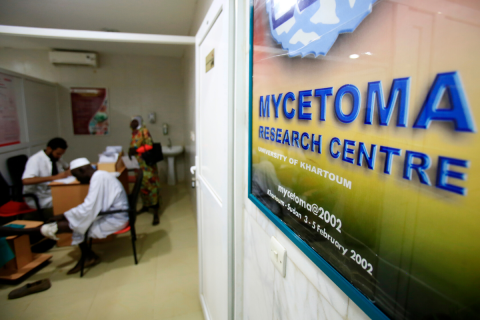Mycetoma – a long journey out of the shadows
Written by Professor Roderick Hay, Dr Kingsley Bampoe Asiedu and Professor Ahmed Fahal (based on the editorial of the same name in Transactions)
Mycetoma is an important disease that affects the poorest of communities, and which has, for a long time, received little scientific or clinical attention.
A recipe for neglect

In part, this has been due to the fact that it is only prevalent in certain countries or in specific regions of countries; also, its progression is slow, it is not painful and managing the disease does not form a major part of the training of frontline health workers.
Taken together, these observations provide a recipe that ensures late presentation of cases, inadequate recognition by health planners and continuing patient disability with consequent stigma, mental health and rejection in local communities.
Khartoum Call for Action
However, in 2016, in response to these major concerns, mycetoma was formally recognised as a neglected tropical disease (NTD) by the WHO.
The subsequent Khartoum Call for Action on Mycetoma of 2019, drafted by experts in the field, set out a clear challenge to promote global recognition and consensus, research, new interventions and engagement of governments, non-governmental organisations and funders.
This challenge has now been taken up by many, but there is still much more to be done.
A special issue on mycetoma
This is why we are thrilled to be publishing a special issue of Transactions which focuses on mycetoma and brings together some of the leading experts in the field, including Wendy van de Sande, Mustafa Elnour Bahar, Elsheikh Mahgoub, Nathalie Strub-Wourgaft, Alexandro Bonifaz and RSTMH President, Professor Gail Davey.
The special issue touches on a range of topics, including the first and sole comparative clinical trial of a new medication for mycetoma that is only now underway in Sudan. This shows how current disease management guidelines have been built on a foundation of anecdotal treatment experience and consensus opinion.
The resources required to assess drug efficacy accurately have not been deployed until now for the alleviation of mycetoma. Inevitably, the imperative for new drug discovery in this disease has been muted, partly because, in a market-driven economy, mycetoma does not appear on the therapeutic needs radar.
Funding and innovation needed urgently
So new funding and innovative approaches to drug development are urgently needed. Yet it would be a mistake to think of mycetoma as an isolated challenge, as new strategies that might unlock the door for mycetoma treatment may also produce benefits in other infectious diseases.
From studies published in this issue, for example “Melanin production in coelomycetous agents of black grain eumycetoma”, we are beginning to recognise that the grain, the defining parasitic structure seen in all mycetomas, shares many of the adaptations seen in a complex microbial biofilm.
In eumycetomas, those caused by fungi, grains also contain elements such as grossly thickened cell walls, containing chitin and glucan, which might provide suitable antifungal targets in other contexts; the grain is also often permeated by melanin, another potential drug target.
Similarly, in finding better treatments for actinomycetomas, those caused by filamentous bacteria, there are potential benefits for other actinomycete infections such as systemic nocardiosis.
At present, mycetoma patients frequently resort to the only source of treatment available to them, traditional medicine, further delaying access to diagnosis and assessment.
The challenge of diagnosis
Laboratory diagnosis is another issue highlighted in the special issue, for example in the article “Actinomycetoma laboratory-based diagnosis: a mini-review”. At present, provision of simple diagnostic assessments is limited throughout many endemic areas. Again, this is due to a mixture of lack of training and facilities.
But as mycetomas are caused by more than 70 different species of fungi or bacteria, accurate identification of individual causes is a key step in prevention and treatment.
New organisms are being recognised all the time and providing accurate identification through their molecular structure is increasingly important in this field. Solving this deficit involves an imaginative combination of training, new diagnostic tests and the recognition of reference centres to support new initiatives in laboratory diagnosis.
Early detection
Early detection of cases is another key theme of this issue and features in “Mycetoma and the Community Dermatology Program, Mexico”. This is equally critical to the delivery of effective control of mycetoma, a feature now highlighted in the WHO NTDs roadmap milestones to meet sustainable development goals by 2030.
These include developing rapid diagnostic tests and effective treatment, as well as establishing surveillance for case detection and reporting within an overall health framework to ensure access to affordable diagnosis and treatment.
This depends on better methods of detection clinically, in the laboratory or by imaging, deployable at frontline health centres or in accessible hospitals or laboratories.
Delivery of this objective involves stepping up the training of health workers to facilitate recognition of this disease, engaging with local populations and creating specific integrated programmes at both national and local levels, key objectives in the plans for the detection and management of NTDs of the skin (or skin NTDs), of which mycetoma is an important member.
Holistic management approach
There is an essential need to adopt a holistic management approach to mycetoma patients that encompasses medical, health, socioeconomic and environmental support for patients, families, community and the health authorities in the affected endemic regions.
The goal of reducing the use of, and eliminating the need for, amputation is an important target.
In his 1874 monograph on mycetoma, Vandyke Carter stated that “future investigations will have to determine the precise means to be employed in attaining useful results, other than are arrived at by the use of the knife”.
Mycetoma patients are still waiting.
